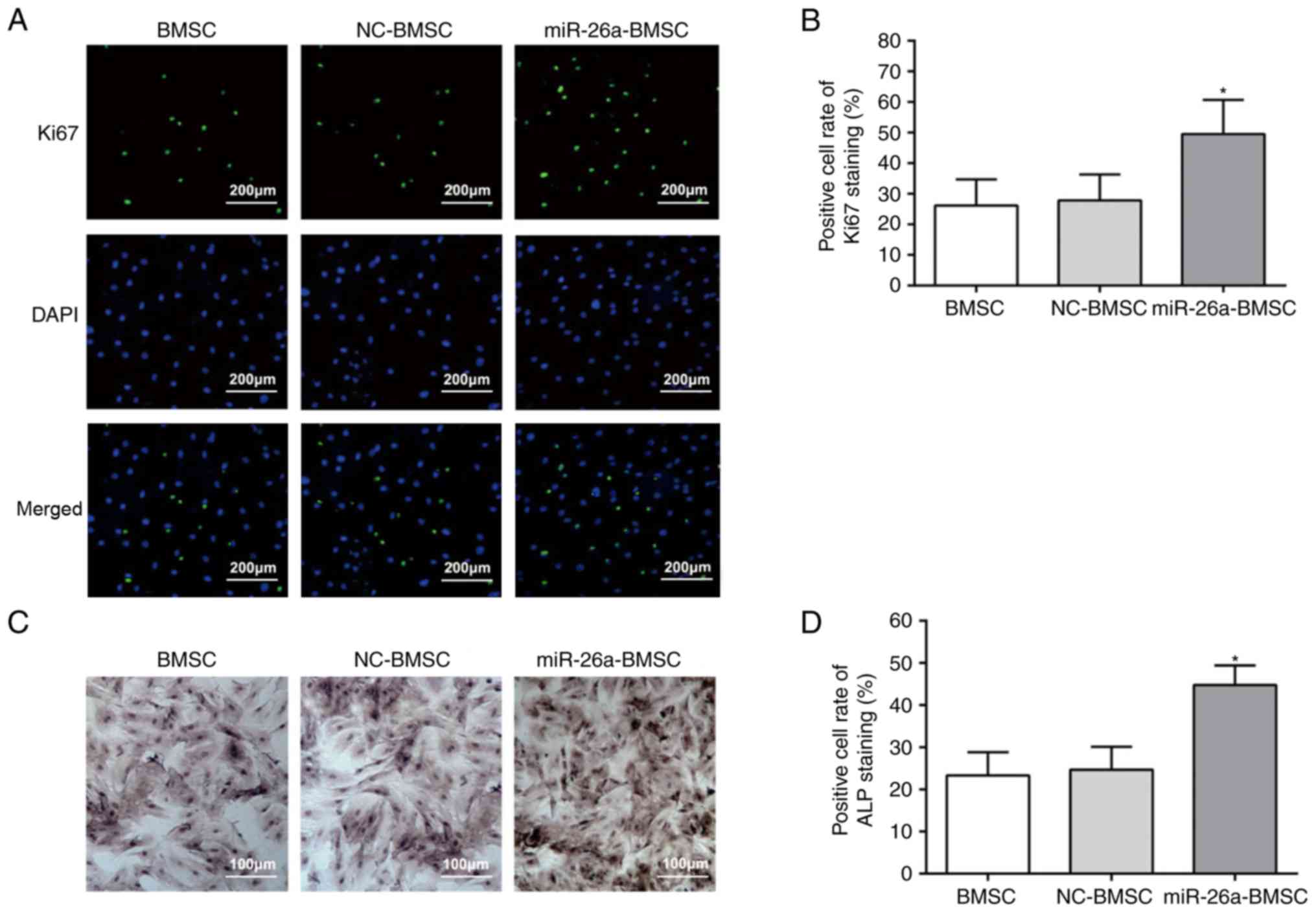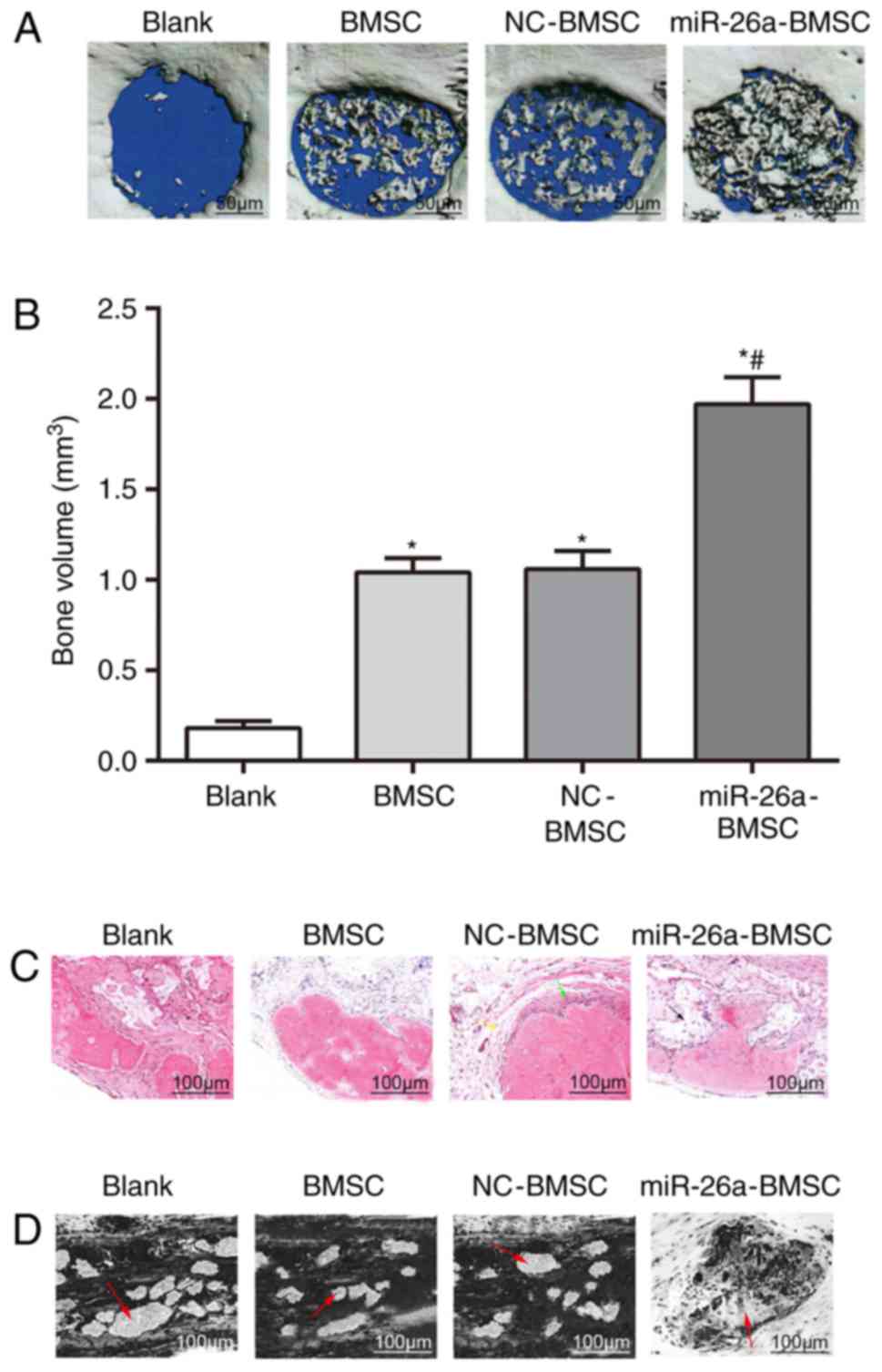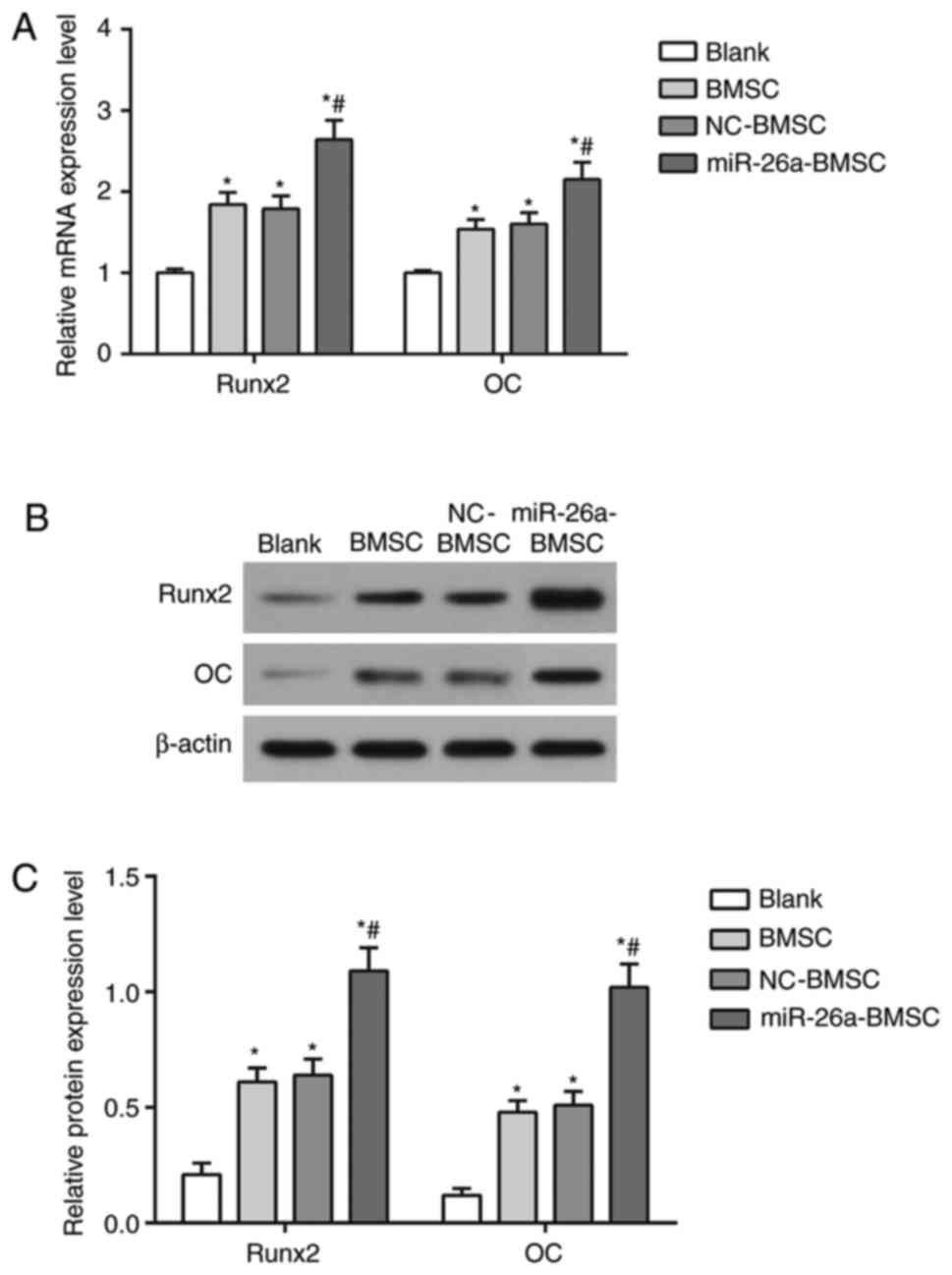|
1
|
Kolambkar YM, Boerckel JD, Dupont KM,
Bajin M, Huebsch N, Mooney DJ, Hutmacher DW and Guldberg RE:
Spatiotemporal delivery of bone morphogenetic protein enhances
functional repair of segmental bone defects. Bone. 49:485–492.
2011. View Article : Google Scholar : PubMed/NCBI
|
|
2
|
Calori GM, Mazza E, Colombo M and
Ripamonti C: The use of bone-graft substitutes in large bone
defects: Any specific needs? Injury. 42 Suppl 2:S56–S63. 2011.
View Article : Google Scholar : PubMed/NCBI
|
|
3
|
Lv J, Xiu P, Tan J, Jia Z, Cai H and Liu
Z: Enhanced angiogenesis and osteogenesis in critical bone defects
by the controlled release of BMP-2 and VEGF: Implantation of
electron beam melting-fabricated porous Ti6Al4V scaffolds
incorporating growth factor-doped fibrin glue. Biomed Mater.
10:0350132015. View Article : Google Scholar : PubMed/NCBI
|
|
4
|
Kusumbe AP, Ramasamy SK and Adams RH:
Coupling of angiogenesis and osteogenesis by a specific vessel
subtype in bone. Nature. 507:323–328. 2014. View Article : Google Scholar : PubMed/NCBI
|
|
5
|
Kolambkar YM, Dupont KM, Boerckel JD,
Huebsch N, Mooney DJ, Hutmacher DW and Guldberg RE: An
alginate-based hybrid system for growth factor delivery in the
functional repair of large bone defects. Biomaterials. 32:65–74.
2011. View Article : Google Scholar : PubMed/NCBI
|
|
6
|
Li J, Hong J, Zheng Q, Guo X, Lan S, Cui
F, Pan H, Zou Z and Chen C: Repair of rat cranial bone defects with
nHAC/PLLA and BMP-2-related peptide or rhBMP-2. J Orthop Res.
29:1745–1752. 2011. View Article : Google Scholar : PubMed/NCBI
|
|
7
|
Zou D, Zhang Z, Ye D, Tang A, Deng L, Han
W, Zhao J, Wang S, Zhang W, Zhu C, et al: Repair of critical-sized
rat calvarial defects using genetically engineered bone
marrow-derived mesenchymal stem cells overexpressing
hypoxia-inducible factor-1α. Stem Cells. 29:1380–1390.
2011.PubMed/NCBI
|
|
8
|
Zhang Y, Wang F, Chen J, Ning Z and Yang
L: Bone marrow-derived mesenchymal stem cells versus bone marrow
nucleated cells in the treatment of chondral defects. Int Orthop.
36:1079–1086. 2012. View Article : Google Scholar : PubMed/NCBI
|
|
9
|
Lin CY, Chang YH, Lin KJ, Yen TC, Tai CL,
Chen CY, Lo WH, Hsiao IT and Hu YC: The healing of critical-sized
femoral segmental bone defects in rabbits using
baculovirus-engineered mesenchymal stem cells. Biomaterials.
31:3222–3230. 2010. View Article : Google Scholar : PubMed/NCBI
|
|
10
|
Liu JL, Jiang L, Lin QX, Deng CY, Mai LP,
Zhu JN, Li XH, Yu XY, Lin SG and Shan ZX: MicroRNA 16 enhances
differentiation of human bone marrow mesenchymal stem cells in a
cardiac niche toward myogenic phenotypes in vitro. Life Sci.
90:1020–1026. 2012. View Article : Google Scholar : PubMed/NCBI
|
|
11
|
Chen S, Yang L, Jie Q, Lin YS, Meng GL,
Fan JZ, Zhang JK, Fan J, Luo ZJ and Liu J: MicroRNA125b suppresses
the proliferation and osteogenic differentiation of human bone
marrowderived mesenchymal stem cells. Mol Med Rep. 9:1820–1826.
2014. View Article : Google Scholar : PubMed/NCBI
|
|
12
|
Xu JF, Yang GH, Pan XH, Zhang SJ, Zhao C,
Qiu BS, Gu HF, Hong JF, Cao L, Chen Y, et al: Altered microRNA
expression profile in exosomes during osteogenic differentiation of
human bone marrow-derived mesenchymal stem cells. PLoS One.
9:e1146272014. View Article : Google Scholar : PubMed/NCBI
|
|
13
|
Zhang J, Han C and Wu T: MicroRNA-26a
promotes cholangiocarcinoma growth by activating β-catenin.
Gastroenterology. 143:246–256, e248. 2012. View Article : Google Scholar : PubMed/NCBI
|
|
14
|
Mohamed JS, Lopez MA and Boriek AM:
Mechanical stretch up-regulates microRNA-26a and induces human
airway smooth muscle hypertrophy by suppressing glycogen synthase
kinase-3β. J Biol Chem. 285:29336–29347. 2010. View Article : Google Scholar : PubMed/NCBI
|
|
15
|
Yang X, Liang L, Zhang XF, Jia HL, Qin Y,
Zhu XC, Gao XM, Qiao P, Zheng Y, Sheng YY, et al: MicroRNA-26a
suppresses tumor growth and metastasis of human hepatocellular
carcinoma by targeting interleukin-6-Stat3 pathway. Hepatology.
58:158–170. 2013. View Article : Google Scholar : PubMed/NCBI
|
|
16
|
Leeper NJ, Raiesdana A, Kojima Y, Chun HJ,
Azuma J, Maegdefessel L, Kundu RK, Quertermous T, Tsao PS and Spin
JM: MicroRNA-26a is a novel regulator of vascular smooth muscle
cell function. J Cell Physiol. 226:1035–1043. 2011. View Article : Google Scholar : PubMed/NCBI
|
|
17
|
Bahi A, Chandrasekar V and Dreyer JL:
Selective lentiviral-mediated suppression of microRNA124a in the
hippocampus evokes antidepressants-like effects in rats.
Psychoneuroendocrinology. 46:78–87. 2014. View Article : Google Scholar : PubMed/NCBI
|
|
18
|
Sun BS, Dong QZ, Ye QH, Sun HJ, Jia HL,
Zhu XQ, Liu DY, Chen J, Xue Q, Zhou HJ, et al: Lentiviral-mediated
miRNA against osteopontin suppresses tumor growth and metastasis of
human hepatocellular carcinoma. Hepatology. 48:1834–1842. 2008.
View Article : Google Scholar : PubMed/NCBI
|
|
19
|
Luzi E, Marini F, Tognarini I, Galli G,
Falchetti A and Brandi ML: The regulatory network menin-microRNA
26a as a possible target for RNA-based therapy of bone diseases.
Nucleic Acid Ther. 22:103–108. 2012. View Article : Google Scholar : PubMed/NCBI
|
|
20
|
Luzi E, Marini F, Sala SC, Tognarini I,
Galli G and Brandi ML: Osteogenic differentiation of human adipose
tissue-derived stem cells is modulated by the miR-26a targeting of
the SMAD1 transcription factor. J Bone Miner Res. 23:287–295. 2008.
View Article : Google Scholar : PubMed/NCBI
|
|
21
|
Ye JH, Xu YJ, Gao J, Yan SG, Zhao J, Tu Q,
Zhang J, Duan XJ, Sommer CA, Mostoslavsky G, et al: Critical-size
calvarial bone defects healing in a mouse model with silk scaffolds
and SATB2-modified iPSCs. Biomaterials. 32:5065–5076. 2011.
View Article : Google Scholar : PubMed/NCBI
|
|
22
|
Williams JR: The declaration of Helsinki
and public health. Bull World Health Organ. 86:650–652. 2008.
View Article : Google Scholar : PubMed/NCBI
|
|
23
|
Mikheev AG: 2 modifications of the
calcium-cobalt method for cytochemical determination of alkaline
phosphatase in leukocytes of the blood and bone marrow. Lab Delo.
12:711–713. 1969.(In Russian). PubMed/NCBI
|
|
24
|
Li J, Jin L, Wang M, Zhu S and Xu S:
Repair of rat cranial bone defect by using bone morphogenetic
protein-2-related peptide combined with microspheres composed of
polylactic acid/polyglycolic acid copolymer and chitosan. Biomed
Mater. 10:0450042015. View Article : Google Scholar : PubMed/NCBI
|
|
25
|
Xu L, Lv K, Zhang W, Zhang X, Jiang X and
Zhang F: The healing of critical-size calvarial bone defects in rat
with rhPDGF-BB, BMSCs, and β-TCP scaffolds. J Mater Sci Mater Med.
23:1073–1084. 2012. View Article : Google Scholar : PubMed/NCBI
|
|
26
|
Livak KJ and Schmittgen TD: Analysis of
relative gene expression data using real-time quantitative PCR and
the 2(-Delta Delta C(T)) method. Methods. 25:402–408. 2001.
View Article : Google Scholar : PubMed/NCBI
|
|
27
|
Li TJ, Browne RM and Matthews JB:
Epithelial cell proliferation in odontogenic keratocysts: A
comparative immunocytochemical study of Ki67 in simple, recurrent
and basal cell naevus syndrome (BCNS)-associated lesions. J Oral
Pathol Med. 24:221–226. 1995. View Article : Google Scholar : PubMed/NCBI
|
|
28
|
Giannoudis PV, Faour O, Goff T, Kanakaris
N and Dimitriou R: Masquelet technique for the treatment of bone
defects: Tips-tricks and future directions. Injury. 42:591–598.
2011. View Article : Google Scholar : PubMed/NCBI
|
|
29
|
Seeliger C, Karpinski K, Haug AT, Vester
H, Schmitt A, Bauer JS and van Griensven M: Five freely circulating
miRNAs and bone tissue miRNAs are associated with osteoporotic
fractures. J Bone Miner Res. 29:1718–1728. 2014. View Article : Google Scholar : PubMed/NCBI
|
|
30
|
van Wijnen AJ, van de Peppel J, van
Leeuwen JP, Lian JB, Stein GS, Westendorf JJ, Oursler MJ, Im HJ,
Taipaleenmäki H, Hesse E, et al: MicroRNA functions in osteogenesis
and dysfunctions in osteoporosis. Curr Osteoporosis Rep. 11:72–82.
2013. View Article : Google Scholar
|
|
31
|
Li KC, Chang YH, Yeh CL and Hu YC: Healing
of osteoporotic bone defects by baculovirus-engineered bone
marrow-derived MSCs expressing MicroRNA sponges. Biomaterials.
74:155–166. 2016. View Article : Google Scholar : PubMed/NCBI
|
|
32
|
Wang Z, Zhang D, Hu Z, Cheng J, Zhuo C,
Fang X and Xing Y: MicroRNA-26a-modified adipose-derived stem cells
incorporated with a porous hydroxyapatite scaffold improve the
repair of bone defects. Mol Med Rep. 12:3345–3350. 2015. View Article : Google Scholar : PubMed/NCBI
|
|
33
|
Paquet J, Moya A, Bensidhoum M and Petite
H: Engineered cell-free scaffold with two-stage delivery of
miRNA-26a for bone repair. Ann Transl Med. 4:2042016. View Article : Google Scholar : PubMed/NCBI
|
|
34
|
Li Y, Fan L, Liu S, Liu W, Zhang H, Zhou
T, Wu D, Yang P, Shen L, Chen J and Jin Y: The promotion of bone
regeneration through positive regulation of angiogenic-osteogenic
coupling using microRNA-26a. Biomaterials. 34:5048–5058. 2013.
View Article : Google Scholar : PubMed/NCBI
|
|
35
|
Jo HN, Kang H, Lee A, Choi J, Chang W, Lee
MS and Kim J: Endothelial miR-26a regulates VEGF-Nogo-B
receptor-mediated angiogenesis. BMB Rep. 50:384–389. 2017.
View Article : Google Scholar : PubMed/NCBI
|
|
36
|
Yuan J, Zhang WJ, Liu G, Wei M, Qi ZL, Liu
W, Cui L and Cao YL: Repair of canine mandibular bone defects with
bone marrow stromal cells and coral. Tissue Eng Part A.
16:1385–1394. 2010. View Article : Google Scholar : PubMed/NCBI
|
|
37
|
Tian H, Bharadwaj S, Liu Y, Ma PX, Atala A
and Zhang Y: Differentiation of human bone marrow mesenchymal stem
cells into bladder cells: Potential for urological tissue
engineering. Tissue Eng Part A. 16:1769–1779. 2010. View Article : Google Scholar : PubMed/NCBI
|
|
38
|
Zhou J, Lin H, Fang T, Li X, Dai W, Uemura
T and Dong J: The repair of large segmental bone defects in the
rabbit with vascularized tissue engineered bone. Biomaterials.
31:1171–1179. 2010. View Article : Google Scholar : PubMed/NCBI
|
|
39
|
Dupont KM, Sharma K, Stevens HY, Boerckel
JD, Garcia AJ and Guldberg RE: Human stem cell delivery for
treatment of large segmental bone defects. Proc Natl Acad Sci USA.
107:3305–3310. 2010. View Article : Google Scholar : PubMed/NCBI
|
|
40
|
Hasegawa N, Kawaguchi H, Hirachi A, Takeda
K, Mizuno N, Nishimura M, Koike C, Tsuji K, Iba H, Kato Y and
Kurihara H: Behavior of transplanted bone marrow-derived
mesenchymal stem cells in periodontal defects. J Periodontol.
77:1003–1007. 2006. View Article : Google Scholar : PubMed/NCBI
|
|
41
|
Su X, Liao L, Shuai Y, Jing H, Liu S, Zhou
H, Liu Y and Jin Y: MiR-26a functions oppositely in osteogenic
differentiation of BMSCs and ADSCs depending on distinct activation
and roles of Wnt and BMP signaling pathway. Cell Death Dis.
6:e18512015. View Article : Google Scholar : PubMed/NCBI
|















